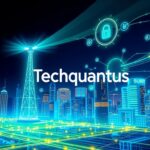Did you know that over 60% of home networks are open to cyber attacks because of weak security? In today’s world, we send our personal data online all the time. It’s crucial to use strong cybersecurity steps to keep our data safe. You play a big part in keeping your home network safe, not just your internet provider.
By using strong network security steps, you can lower the chance of hackers getting in. This keeps your personal and financial info safe from online threats.
Key Takeaways
- Over 60% of home networks are under-secured, increasing the risk of cyber attacks.
- Implementing strong security measures is essential to protect your personal data.
- Both users and service providers share the responsibility of maintaining cybersecurity.
- Adopting network security best practices can deter unauthorized access.
- Keeping your home network secure is critical for safeguarding financial information.
Understanding the Importance of Securing Your Home Network
Keeping your home network safe is key in today’s digital world. The threats to personal data are always changing. If your network isn’t secure, you could face big risks like network theft or data breaches. Hackers look for weak spots in home networks to get to sensitive info like passwords and bank details.
Not having good cybersecurity puts you and others at risk. Someone with the wrong access can attack other users or systems. This makes the threat even bigger. Knowing these risks helps you take steps to make your network safer.
To fight these risks, learn about the threats and how to protect your home network security. For more tips on cybersecurity, check out this helpful guide. Using the right security tools can make it harder for hackers to get into your data.
| Threat | Description | Impact on Personal Data |
|---|---|---|
| Network Theft | Unauthorized access to your home network. | Loss of control over sensitive information. |
| Data Breaches | Exposure of personal data due to weak security. | Identity theft or financial loss. |
| Malware Infections | Infiltration of harmful software through unsecured networks. | Corruption or theft of files and data. |
Common Security Threats to Home Networks
Your home network faces many cybersecurity threats. Knowing these threats helps protect your digital space.
Cybercriminals use different tactics to exploit your network. Here are some common threats:
- Malware: This harmful software can enter your network through email attachments or downloads. Once in, it can harm your devices and steal sensitive data.
- Phishing: These scams try to trick you into sharing personal info by pretending to be trustworthy. They can come through email or messages, leading to financial or identity theft.
- Unauthorized Access: If your devices or Wi-Fi are not secure, hackers can get in. They use these openings to access your network and steal data.
Let’s look at a table that shows different threats and their effects:
| Threat Type | Description | Potential Impact |
|---|---|---|
| Malware | Malicious software infiltrates devices. | Data loss, system damage, unauthorized access. |
| Phishing | Tricks users into revealing sensitive information. | Identity theft, financial loss. |
| Unauthorized Access | Access through unsecured devices. | Data breaches, compromised privacy. |
Knowing about these threats helps you protect your devices and info. For more info, check out privacy policies and practices. Keep your network safe by updating security settings and staying alert for phishing scams.
Steps to Set Up a Secure Home Network
Setting up a secure home network means taking steps to keep your devices and data safe. By doing this, you boost your cybersecurity. It’s important to protect your network from unauthorized access.
Change Default Credentials for Network Devices
Start by changing default credentials on your devices. Many devices come with easy-to-find usernames and passwords. Leaving these as is makes your network an easy target for hackers.
To improve security, change these to unique, complex passwords. Use a mix of letters, numbers, and symbols. This simple step greatly reduces the risk of unauthorized access.
Implement Strong Passwords
After changing default settings, make sure to use strong passwords for all devices. A good password is at least eight characters long. It should include uppercase and lowercase letters, numbers, and symbols.
Update these passwords often and don’t reuse them across different accounts. For more tips on keeping your network secure, check out this article on cloud security challenges and how to deal with them here.
Utilize Encryption for Your Wireless Network
Using wireless network encryption is key to cybersecurity at home. When you connect many devices to your secure Wi-Fi, keeping data safe is crucial. WPA3 encryption is more secure than older versions like WEP or WPA2. It creates a strong wall against hackers, keeping your data safe.
When setting up your network, change the default settings. These defaults are easy targets for hackers. By changing them, you make your network harder to breach. Also, a strong password makes your secure Wi-Fi even safer. A unique, complex password stops hackers from getting in, keeping your data safe.

Choosing wireless network encryption shows you care about keeping data safe for everyone. With more smart devices at home, strong encryption keeps all users safe. These steps make your home network stronger against cyber threats.
For more info on keeping data safe, check out this resource on cloud services.
Cybersecurity Best Practices for Device Management
Managing your devices well is key to keeping your home network safe. Using cybersecurity best practices helps reduce risks from outdated software or unprotected devices.
Regular Software Updates
Keeping your devices updated is crucial for security. Updates often fix security issues, so it’s important to apply them quickly. Not updating can expose your devices to attacks, like the ransomware attack in Columbus, Ohio, which compromised sensitive data. Always turn on automatic updates to make this easier.
Using Antivirus Software
Good antivirus software is a must for protecting your devices. It finds and removes threats that other security steps might miss. Keeping your antivirus current helps it fight off new cyber threats. This is key to a strong security plan. For more on the dangers of poor cybersecurity management, check out this link.
| Practice | Description | Frequency |
|---|---|---|
| Software Updates | Install patches and updates to fix vulnerabilities. | Monthly or as available |
| Antivirus Software | Utilize software to detect and remove malware. | Real-time with regular updates |
| Device Security | Implement password protection and encryption. | As needed |
Following these cybersecurity best practices can make your secure devices much safer. It helps protect against data breaches and other cyber threats.
Segmenting Your Network for Enhanced Security
Network segmentation is key to boosting your cybersecurity. It means dividing your network into smaller, secure areas. This way, you can protect different devices better. For example, keep work devices separate from entertainment gadgets like smart TVs and gaming consoles.
This method not only makes devices safer but also reduces the risk of threats spreading. If a hacker gets into one area, they can’t easily move to others. Companies are now seeing the benefits of this approach, especially for protecting sensitive data and meeting legal standards.

There’s a growing interest in advanced security like Zero Trust Network Access (ZTNA). It checks every time someone tries to get into the network. This fits well with network segmentation, keeping sensitive data safe from unauthorized access. Cloudflare is a big name in ZTNA, having made key moves to improve its security offerings.
More companies are using cloud services, making strong cybersecurity more important. The network consulting market is expected to grow, showing the need for custom solutions. Taking steps like network segmentation can help protect your digital world now and in the future.
For more on how ZTNA affects modern security, check out this insightful report.
Parental Controls: Protecting Young Users
In today’s digital world, keeping kids safe online is key. Using parental controls is vital to shield them from harmful content and cyber dangers. Studies show that 39% of families with kids use these tools at home.
Many routers have built-in parental controls. These let you set filters, control access times, and watch what they do online. Limiting screen time is a common use, with 72% of parents doing this. This shows how important internet safety is to them, as 65% put it at the top of their list.
Talking to kids about safe internet use is crucial. It’s important to warn them about dangers like phishing scams and cyberbullying. A survey revealed that 76% of parents talk to their kids about staying safe online. But, 34% of kids still find harmful content, showing there’s still a lot to do.
Eighty percent of parents think parental controls have made their kids safer online. But, teens often try to get around these rules, with 44% trying to bypass them. Using strong cybersecurity for families can help solve these problems, making the internet safer for everyone.
| Statistics | Percentage |
|---|---|
| Households using parental controls | 39% |
| Parents citing internet safety as a top concern | 65% |
| Parents using parental controls on devices | 56% |
| Children encountering inappropriate content | 34% |
| Parents monitoring online activities | 48% |
| Parents limiting screen time | 72% |
| Parents believing in the effectiveness of parental controls | 80% |
| Teens evading parental controls | 44% |
| Parents discussing online safety | 76% |
| Parents confident in managing online activities | 62% |
The Role of Firewalls in Home Network Security
Firewalls are key to protecting your home network. They watch and control what data comes in and out. This helps keep your network safe from cyber threats.
Many routers have firewalls built-in, making it easy to start securing your network. But, make sure these settings are right. Check them often to keep your network safe.
Using both hardware and software firewalls adds extra protection. This makes it harder for hackers to get into your network. It’s a strong way to keep your network security up to date.
Firewalls are a big part of keeping your home safe online. Knowing how they work helps you keep your network secure and strong.
Monitoring Your Home Network for Unusual Activity
Keeping an eye on your home network is key to staying safe online. Regular checks help spot threats early. Use tools or your router’s features to watch all devices on your network. This way, you can catch unauthorized devices that might mean someone has hacked your network.
It’s vital to set up cybersecurity alerts. These alerts warn you about things like sudden traffic, unauthorized logins, or odd activity. The ‘2024H1 Threat Review’ by Forescout shows a 43% jump in vulnerabilities, with 23,668 found in the first half of 2024.
Twenty percent of these threats target VPNs and network gear, crucial for home networks. Also, ransomware attacks rose by 6%, hitting many in the U.S. Good network monitoring can protect your home from these threats.
- Use network monitoring software to always check what devices are doing.
- Look over connection logs for any signs of unauthorized access.
- Set up alerts for strange patterns that could mean a breach.
Stay updated with the latest cybersecurity news to improve your defenses. For more tips on securing your home network, check out this resource.
By staying alert and monitoring closely, you can greatly improve your home network’s security. This reduces the risks from new cyber threats.
Building a Culture of Cybersecurity Awareness
Creating a strong culture of cybersecurity awareness is key for your home network’s safety. It means giving employee training for remote work and teaching family education about safe online habits. Regular sessions can help everyone know how to spot and deal with threats.
It’s vital to understand cybersecurity best practices. Schools, businesses, and families must make sure everyone knows the basics. Sharing news about recent threats, like malware that looks like normal software, helps prevent attacks. Talking about the latest scams and common mistakes is also crucial.
Combining formal training for employees with chats at home makes a strong cybersecurity team. When people know what to do, they can make your home network much safer against new threats.
| Key Areas of Focus | Action Items | Expected Outcomes |
|---|---|---|
| Awareness Training | Organize regular training sessions | Increased knowledge of threats |
| Family Education | Conduct discussions about online safety | Safer internet practices at home |
| Sharing Information | Send newsletters on recent threats | Timely updates on cybersecurity issues |
| Encouraging Participation | Involve everyone in security discussions | Stronger community engagement |
By focusing on cybersecurity awareness, you create a place where everyone looks out for each other’s online safety. This approach helps prevent breaches and keeps the digital world safer for everyone.
Conclusion
Keeping your home network safe is a big job that needs many steps. Changing default passwords, using strong encryption, and updating devices are key steps. These actions help protect your personal info and keep your network safe from hackers.
It’s also vital to teach your family about online safety. Learning about threats and safe browsing can lower the risk of security problems. When everyone knows how to stay safe online, your whole home is more secure.
In the end, making your home network secure is about more than just protecting devices. It’s about creating a safe space for everyone to use the internet. By following these steps now, you’re making your network stronger for the future.
FAQ
Why is it important to secure my home network?
Keeping your home network safe is key to protecting your personal data from hackers. Without good security, you could lose sensitive info like passwords and bank details.
What are common threats to home network security?
Home networks can face threats like malware, phishing, and unauthorized access from unsecured devices. Knowing these risks helps you take the right steps to protect your network.
How can I change default credentials on my devices?
Change default settings by going to your router’s web page. Look for security or admin options to set up a unique username and strong password for your devices.
What encryption should I use for my wireless network?
Use WPA3 for wireless encryption because it’s more secure than older types like WEP or WPA2. It keeps your data safe as it moves between devices.
How often should I update my devices and software?
Update regularly to stay secure; check for updates once a month. This keeps your devices safe from new threats by fixing known issues.
What are the benefits of network segmentation?
Segmenting your network means creating separate areas for different devices. This reduces the risk of threats spreading and makes your network more secure by limiting device communication.
How can I use parental controls to enhance security?
Use parental controls on your router to filter content and limit access times. Teach your kids about safe internet use to protect them even more.
Why are firewalls important for my home network?
Firewalls watch and control traffic to and from your network, keeping out unauthorized access. Make sure they’re set right on your router and add software firewalls on devices for extra security.
How can I monitor my network for unusual activity?
Use network monitoring tools or your router’s features to keep an eye on your network. Watch for unknown devices and set alerts for odd traffic patterns, like sudden spikes, which could mean a security issue.
What steps can I take to promote a culture of cybersecurity awareness?
Teach your work-from-home colleagues and talk with your family about safe online habits. Sharing updates on cybersecurity threats helps everyone help protect your network.
Source Links
- https://federalnewsnetwork.com/federal-report/2024/09/security-in-the-age-of-telework-continues-to-be-a-shared-responsibility/
- https://securityboulevard.com/2024/09/columbus-sues-expert-fueling-debate-about-ransomware-attack/
- https://blogs.opentext.com/what-are-opentext-ai-assistants/
- https://therecord.media/spamouflage-influence-operation-china
- https://natlawreview.com/article/whos-watching-watchers-ftc-files-proposed-order-against-security-camera-company
- https://mycareer.verizon.com/jobs/r-1047707/business-sales-account-manager/
- https://techcommunity.microsoft.com/t5/microsoft-defender-xdr-blog/unlocking-real-world-security-defending-against-crypto-mining/ba-p/4228815
- https://mycareer.verizon.com/jobs/r-1046178/act-mgr-rtl-smb-business-sls/
- https://www.networkcomputing.com/network-management/what-is-cloud-virtual-desktop-infrastructure-vdi-
- https://www.prnewswire.com/news-releases/hest-investments-announces-strategic-investment-in-american-binary-to-drive-quantum-computing-security-302235105.html
- https://www.openpr.com/news/3644285/zero-trust-network-access-market-expansion-current-dynamics
- https://www.linkedin.com/pulse/network-consulting-market-share-trends-analysis-2024-2031-etc5f
- https://uk.finance.yahoo.com/news/explainer-issue-cathay-pacifics-a350-032656714.html
- https://en.prnasia.com/releases/apac/av-comparatives-identifies-key-cybersecurity-threats-for-summer-2024-fakeshops-phishing-attacks-and-targeting-children-459423.shtml
- https://menafn.com/1108632606/MENA-Companies-Turn-To-Outsourced-Security
- https://cybersecuritynews.com/bonjour-privilege-escalation/
- https://securityaffairs.com/167973/hacking/microsoft-apps-for-macos-flaws.html
- https://uk.finance.yahoo.com/news/news-invl-technology-managed-companies-065000829.html
- https://industrialcyber.co/reports/forescout-reports-cyber-threats-surge-state-sponsored-hackers-target-vpn-vulnerabilities-ransomware-attacks-rise/
- https://em360tech.com/tech-article/tfl-cyber-attack
- https://www.darkreading.com/threat-intelligence/evolving-npm-package-campaign-roblox-devs
- https://www.govtech.com/security/critical-infrastructure-how-to-protect-water-power-and-space-from-cyber-attacks
- https://jpt.spe.org/taqas-commitment-to-sustainable-oil-and-gas-well-cementing-a-pioneering-approach-to-environmental-stewardship
- https://link.springer.com/chapter/10.1007/978-981-97-5204-1_9
- https://cyble.com/blog/cert-in-advisory-and-wikiloader-campaign-comprehensive-overview-of-recent-security-threats/
- Quantum Computing Basics for Beginners: A Simplified Guide
- I Use Prompt Engineering Templates That Work Across ChatGPT, Gemini, Claude & Grok
- I Use Small Business AI Stack: Affordable Tools to Automate Support, Sales, Marketing
- Remote Work Productivity Tips: Maximize Efficiency
- The AI Snitch: Why Grassing Out Colleagues, Even for “Efficiency,” Backfires
Related posts:
 How to Protect Your Business from Ransomware Attacks
How to Protect Your Business from Ransomware Attacks
 Phishing Attacks: How to Spot and Prevent Them
Phishing Attacks: How to Spot and Prevent Them
 The Impact of Quantum Computing on Cybersecurity
The Impact of Quantum Computing on Cybersecurity
 IAM Introduction: Identity Access Management Basics
IAM Introduction: Identity Access Management Basics
 Access Control Concepts: Safeguarding Systems and Data in Cybersecurity
Access Control Concepts: Safeguarding Systems and Data in Cybersecurity
 The Impact of 5G on IT Infrastructure and Security
The Impact of 5G on IT Infrastructure and Security
